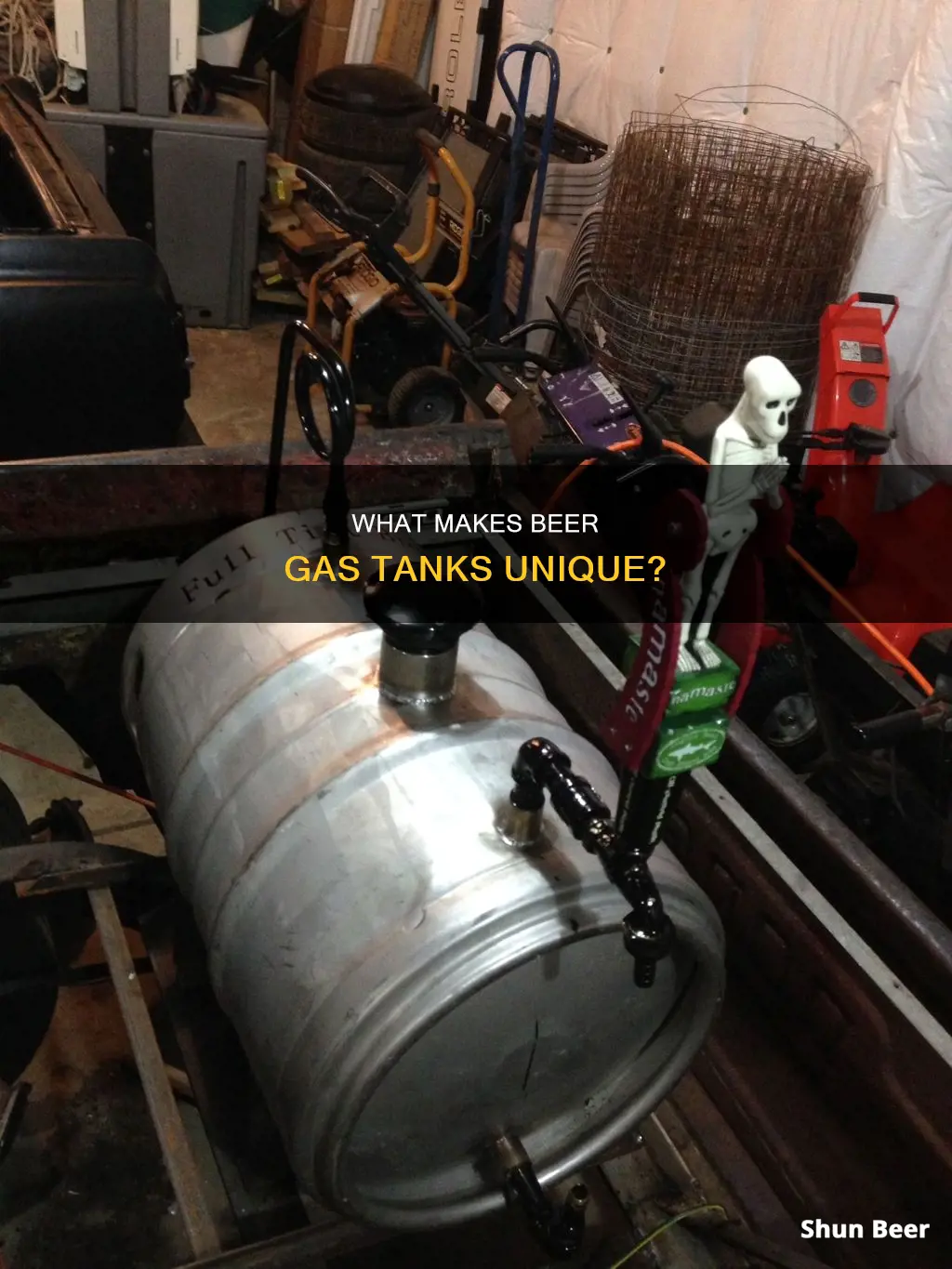
When it comes to storing and dispensing beer, the type of gas tank you use is crucial. The two main options are CO2 and nitrogen tanks, each serving a distinct purpose. CO2 tanks are typically used for carbonating and dispensing regular beers, while nitrogen tanks are essential for dispensing stouts like Guinness, achieving that creamy texture and cascading effect. The choice of tank depends on the type of beer you plan to serve, and it's important to note that nitrogen tanks require specific regulators due to the higher pressure they operate at. Additionally, the size and material of the tank, such as aluminum or steel, are also factors to consider.
| Characteristics | Values |
|---|---|
| Purpose | Storing, cooling and dispensing draft beer |
| Gas type | Carbon dioxide or nitrogen |
| Beer type | Carbon dioxide for regular beers; nitrogen for stouts like Guinness |
| Size | 2.5 lb, 5 lb, 10 lb, 20 lb |
| Material | Aluminum or steel |
| Filling | Can be filled at local gas dealers or welding supply companies |
What You'll Learn

CO2 vs Nitrogen tanks
CO2 and nitrogen tanks are used to store and dispense beer. While both types of tanks are used for the same purpose, there are some key differences between them.
CO2 has been used in brewing and distilling processes for many years. It is used to remove air and protect the product from oxidation, ensuring good taste, mouthfeel, quality, and shelf stability. CO2 can be pumped into kegs and kept at pressure to carbonate beer and give it a foamy texture. CO2 is often transported as a cryogenic liquid, requiring specialised trailers and railcars for transportation. CO2 tanks come in various sizes, and the size you need will depend on your monthly use volume and the proximity of your use site to the supply source. It is important to ensure that you do not have an undersized tank, as the expense of additional delivery charges and the threat of run-outs is far more expensive than the savings of buying a smaller tank.
Nitrogen serves some of the same purposes as CO2, such as protecting against oxygenation, extending shelf life, and improving taste and aroma. It is used in pressurized containers and can be incorporated before or after filling and before capping and seaming. Nitrogen is less soluble than CO2, which gives it a unique mouthfeel and smoothness. It is important to note that nitrogen is not beneficial for hop-forward beers that are meant to have a bite to them rather than a creamy consistency. Nitrogen can also be used for various applications, including cleaning, pressurizing, and inerting, making it a practical and cost-efficient choice.
When it comes to choosing between a CO2 and nitrogen tank, the type of beer you plan to dispense will be the deciding factor. If you are dispensing regular types of beer, a carbon dioxide tank is the best option. On the other hand, if you are planning to dispense Guinness beer or other stouts, a nitrogen cylinder is required. Additionally, if you are dispensing coffee or wine, you will need a tank that is 100% nitrogen. It is worth noting that nitrogen tanks are rated for a much higher pressure than CO2 tanks, and nitrogen is typically measured by pressure while CO2 is measured by weight.
Explore the Difference Between Ales and Lagers
You may want to see also

Gas requirements for different beers
The type of beer gas tank you should use depends on the type of beer you are planning to dispense. If you are dispensing regular types of beer, a carbon dioxide (CO2) tank is the best option. CO2 tanks are also suitable for ales and lagers, which have more than twice the CO2 volumes than nitrogenated stout-style beers.
If you are dispensing Guinness beer or other stouts, nitrogenated (nitro) beers, or coffee or wine, you will need a nitrogen (N2) tank. Nitrogen is used to push the beer from the keg and give it a creamy body, as it does not dissolve into the beer. Nitrogen tanks are rated for a much higher pressure than CO2 tanks.
The ratio of nitrogen to CO2 in a beer gas blend can vary depending on the type of beer. Nitro-infused beers use a higher percentage of nitrogen—a common mix is 30% CO2 and 70% nitrogen. Stouts require more nitrogen and would become overly carbonated if dispensed with regular CO2 gas. A blend with a higher percentage of CO2 is better suited for lagers and IPAs.
It is important to note that nitrogen tanks require a different type of regulator designed specifically for nitrogen dispensing, as nitrogen is dispensed at a much higher psi than CO2.
Beer vs Lager: What's the Difference?
You may want to see also

Tank size
When it comes to tank size, beer gas tanks typically range from 2.5 lb to 20 lb tanks, with some sources stating that tanks can go up to 50 lb. The size of the tank you need will depend on how many kegs you intend to dispense and the type of beer you are serving.
For home beer dispensing, 1 lb and 5 lb CO2 tanks are the most common. A 5 lb CO2 tank has a volume of 300 liters of CO2 and can dispense 3-4 full-size kegs. A 15 lb CO2 tank, on the other hand, can last for around 13-18 half kegs. If you are serving a high volume of draft beer, a larger tank may be more suitable to avoid frequent refills.
Nitrogen tanks are typically used for dispensing stouts such as Guinness. These tanks are available in 10 lb sizes, which can be used for dispensing at least 8 half-barrel kegs.
It is important to note that the size of the tank may also depend on the material it is made of. Aluminum tanks are typically used for smaller cylinders ranging from 5-20 lb, while larger cylinders made of steel are used for commercial settings.
Explore the Difference Between Ales and Lagers in Beer
You may want to see also

Tank material
Beer gas tanks are made from either aluminium or steel. Most experts agree that aluminium tanks are superior because they are more lightweight and resistant to corrosion. They are also rust-proof. However, steel tanks are rated for much higher pressure than aluminium tanks.
Aluminium tanks are usually made from a high-strength aluminium alloy, such as 6061-T6. They are lighter than steel tanks and are often used for CO2, which is monitored by a regulator to control the flow of beer from keg to faucet.
Steel tanks are typically used for nitrogen, which is required for dispensing stouts such as Guinness. They are also used for CO2 and can be filled at local gas dealers or welding supply companies.
Both aluminium and steel tanks come in different sizes, usually measured in pounds of CO2 or nitrogen they can hold. Common sizes range from 2.5 lb to 20 lb tanks.
Explore the Diverse World of Beer Styles
You may want to see also

Gas tank safety
Gas tanks are essential for storing and dispensing beer, but they can also be dangerous if not handled properly. Here are some detailed safety instructions for using gas tanks:
Choosing the Right Gas Tank
Before using a gas tank, it's important to select the right type for your needs. The two main options are carbon dioxide (CO2) tanks and nitrogen tanks. Regular beer types are typically dispensed using CO2 tanks, while stouts, like Guinness, require nitrogen cylinders. It's also important to choose the right size and material for your tank. Most home brewers prefer 5-lb CO2 cylinders for their optimal size, weight, and portability. Aluminum cylinders are generally recommended over steel due to their lightweight and corrosion-resistant properties.
Handling and Storage
When handling gas tanks, always use the proper equipment, including safety glasses, heavy-duty gloves, and protective footwear. Avoid dropping or hitting the tanks, and ensure safety measures such as caps or guards are securely installed. Use a cart or hand truck for transportation instead of dragging or rolling the tanks. Keep the tanks in a well-ventilated area, away from heat sources, sparks, and flames. Always store gas tanks in a secure, upright position.
Pressure and Regulator Safety
Monitor tank pressure and do not exceed recommended levels. Always connect the gas cylinder to a reducing valve or regulator. Never connect the gas cylinder directly to a keg. Use a regulator to control delivery pressure, but not for flow control. Ensure the regulator is compatible with the gas type and cylinder size. Regularly adjust the pressure adjustment handle to maintain a constant outlet pressure.
Leakage and Emergency Procedures
In the event of a gas leak, ventilate the area immediately. If abnormal concentrations of carbon dioxide are suspected, close the main valve on the gas cylinder and leave the room. Evacuate the area and contact emergency personnel if the leak cannot be fixed by tightening fittings or if any other emergency situation arises. Develop comprehensive emergency procedures specific to your organization for handling gas cylinder-related incidents.
Stout vs Porter: Unveiling Beer's Dark Secrets
You may want to see also
Frequently asked questions
Beer gas is a blend of nitrogen and carbon dioxide (CO2). It typically consists of 70% nitrogen and 30% CO2, but these proportions can vary.
CO2 tanks are used for carbonating and dispensing beers that require carbonation. Nitrogen tanks are used for dispensing nitrogenated beers, like Guinness, which require a nitrogen gas blend for proper dispensing. Nitrogen tanks are rated for much higher pressure than CO2 tanks.
You should first decide on the type of gas – carbon dioxide or nitrogen – based on the type of beer you plan to dispense. Then, consider the size of the tank (e.g. 5-lb or 10-lb) and the material it is made of (aluminium or steel). Aluminium tanks are more lightweight and resistant to corrosion, while steel tanks may be more durable.







